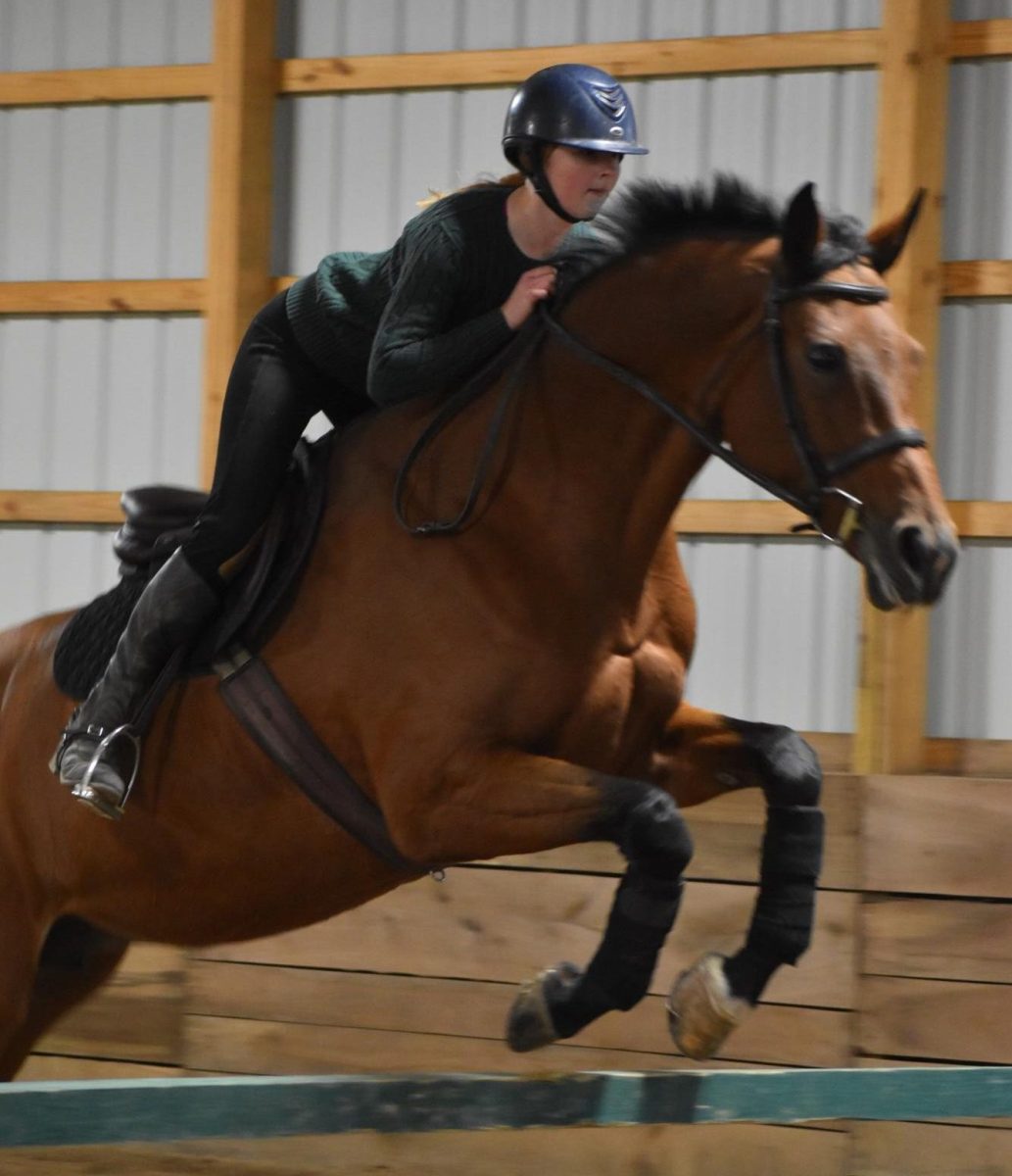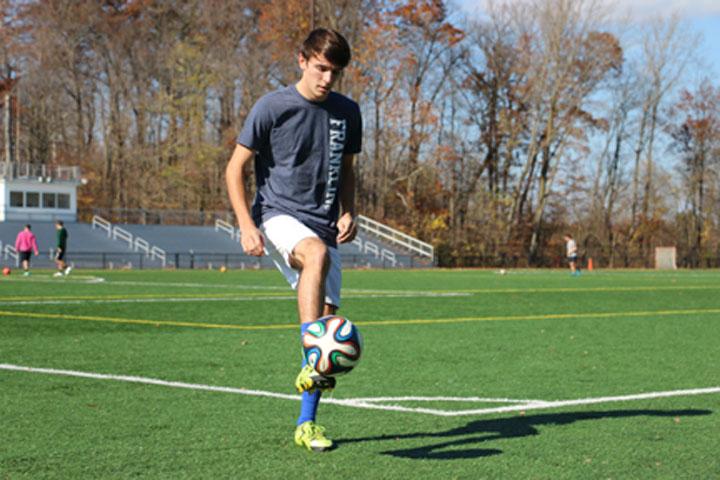Like many CHS seniors, varsity soccer player Tyler Majeski went through the college selection process, yet unlike many of his other classmates, Majeski will be continuing his soccer career at the collegiate level. Next fall, Majeski will not only be a Franklin College Grizzly, but also don a navy blue and gold soccer uniform. Franklin College is a Division III s chool, located in Franklin, IN, just south of Indianapolis, in the National Collegiate Athletic Association (NCAA). While Majeski had opportunities to attend Division I or Division II schools, Majeski said he found Division III to be the best fit for him. Majeski said, “I wouldn’t play (as much) so I chose a DIII school so I get a lot of playing time.”
chool, located in Franklin, IN, just south of Indianapolis, in the National Collegiate Athletic Association (NCAA). While Majeski had opportunities to attend Division I or Division II schools, Majeski said he found Division III to be the best fit for him. Majeski said, “I wouldn’t play (as much) so I chose a DIII school so I get a lot of playing time.”
The NCAA has three divisions for collegiate athletics: Division I, Division II, and Division III. According to the NCAA, Division I schools are larger, containing more students and larger budgets than other schools while also maintaining high academic standards for their athletes. Division II schools focus more on academic and social standards of athletes while Division III schools make academics the main focus of their student athletes.
Athletics Director Jim Inskeep said while Division I schools have the allure of competitive play, Division III schools normally offer students more, especially in scholarship money. Inskeep said, “Sometimes those better opportunities are at the Division III level, the opportunity to maybe start as a freshman, to get more money academically and athletically at that school as well.”
Inskeep also said student athletes should plan for the future outside of sports. He said, “I would hope at some point whatever (a student athlete’s) majoring in and (their) career after the ball stops bouncing is a major factor as well because really those that all go on to college it’s not about just saying you’re going on to college.” Inskeep said he hopes student athletes realize this and use that in their decision on where to go for college.
Lauryn Padgett, tennis player and senior, said she chose to attend Division I Dayton University because of the scholarships she was able to receive. Padgett said, “You can get athletic money as well as academics.” Padgett plans on going on to graduate school, so the money she is able to save in college was helpful for her future.
While Padgett has received money from a Division I school, Inskeep says most student athletes attending Division I schools will not. Inskeep said, “I think that a lot of our student athletes have a vision of playing at the Division I level but for some of them that’s playing without a lot of money involved from scholarship standpoint.”
Inskeep said many Division III schools offer more for students, especially financially. Inskeep said, “There are a lot of opportunities at the Division III level where you might not be getting athletic money but you are getting significant academic money.” He said some schools even offer up to half of a student’s tuition as well as their room and board. Majeski said, “(Franklin College) is giving me a decent amount (of scholarship money) in, like, academics, plus throwing in for soccer a little bit (of money).”
Majeski said that scholarship money for athletics depends on how good the player is. The better the player, the more money he or she receives. Inskeep said that many student athletes going to Division III schools will receive academic scholarships and that the classroom opportunities at CHS help those students receive those scholarships.
Inskeep said, “Well, from an academic standpoint, I think what goes on in the classroom speaks volumes here for all of our students, but especially for our student athletes just because of the types of courses they can take to prepare them for college.”
Majeski said grades are essential to getting offers from colleges. Majeski said, “If you don’t have good grades you can’t play. My parents make me keep (my GPA) up at like a 3.4.” Inskeep said, “Sometimes you have to have students realize that Division I may not happen for them and that they need to keep their options open if playing is that important a deal for them moving forward in college.” Majeski said, “A lot of kids who go DI don’t play but players who go to a DII or DIII school, they get a lot more playing time. There’s not really a difference in quality of sports at like a DI versus a DIII school, just the size of the players and, how they play and different coaching styles.”


































![British royalty are American celebrities [opinion]](https://hilite.org/wp-content/uploads/2024/03/Screenshot-2024-03-24-1.44.57-PM.png)


















![Review: “Suits” is a perfect blend of legal drama and humor [MUSE]](https://hilite.org/wp-content/uploads/2024/04/unnamed-1.png)
![Chelsea Meng on her instagram-run bracelet shop [Biz Buzz]](https://hilite.org/wp-content/uploads/2024/04/IMG_2446-1200x838.jpg)
![Review: Quiet on Set: The Dark Side of Kids TV is the long awaited exposé of pedophilia within the children’s entertainment industry [MUSE]](https://hilite.org/wp-content/uploads/2024/04/unnamed.jpg)
![Review: “The Iron Claw” cannot get enough praise [MUSE]](https://hilite.org/wp-content/uploads/2024/04/unnamed.png)
![Review: “The Bear” sets an unbelievably high bar for future comedy shows [MUSE]](https://hilite.org/wp-content/uploads/2024/03/unnamed.png)
![Review in Print: Maripaz Villar brings a delightfully unique style to the world of WEBTOON [MUSE]](https://hilite.org/wp-content/uploads/2023/12/maripazcover-1200x960.jpg)
![Review: “The Sword of Kaigen” is a masterpiece [MUSE]](https://hilite.org/wp-content/uploads/2023/11/Screenshot-2023-11-26-201051.png)
![Review: Gateron Oil Kings, great linear switches, okay price [MUSE]](https://hilite.org/wp-content/uploads/2023/11/Screenshot-2023-11-26-200553.png)
![Review: “A Haunting in Venice” is a significant improvement from other Agatha Christie adaptations [MUSE]](https://hilite.org/wp-content/uploads/2023/11/e7ee2938a6d422669771bce6d8088521.jpg)
![Review: A Thanksgiving story from elementary school, still just as interesting [MUSE]](https://hilite.org/wp-content/uploads/2023/11/Screenshot-2023-11-26-195514-987x1200.png)
![Review: When I Fly Towards You, cute, uplifting youth drama [MUSE]](https://hilite.org/wp-content/uploads/2023/09/When-I-Fly-Towards-You-Chinese-drama.png)
![Postcards from Muse: Hawaii Travel Diary [MUSE]](https://hilite.org/wp-content/uploads/2023/09/My-project-1-1200x1200.jpg)
![Review: Ladybug & Cat Noir: The Movie, departure from original show [MUSE]](https://hilite.org/wp-content/uploads/2023/09/Ladybug__Cat_Noir_-_The_Movie_poster.jpg)
![Review in Print: Hidden Love is the cute, uplifting drama everyone needs [MUSE]](https://hilite.org/wp-content/uploads/2023/09/hiddenlovecover-e1693597208225-1030x1200.png)
![Review in Print: Heartstopper is the heartwarming queer romance we all need [MUSE]](https://hilite.org/wp-content/uploads/2023/08/museheartstoppercover-1200x654.png)






















![Review: Ladybug & Cat Noir: The Movie, departure from original show [MUSE]](https://hilite.org/wp-content/uploads/2023/09/Ladybug__Cat_Noir_-_The_Movie_poster-221x300.jpg)

![Review: Next in Fashion season two survives changes, becomes a valuable pop culture artifact [MUSE]](https://hilite.org/wp-content/uploads/2023/03/Screen-Shot-2023-03-09-at-11.05.05-AM-300x214.png)
![Review: Is The Stormlight Archive worth it? [MUSE]](https://hilite.org/wp-content/uploads/2023/10/unnamed-1-184x300.png)




